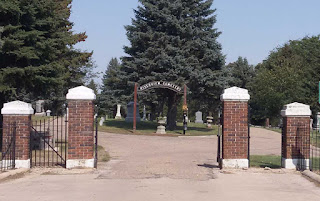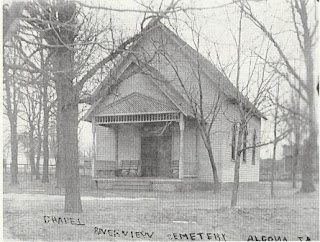I don't know about you, but I like
to visit cemeteries. When I was a young girl, my house was right across
the railroad tracks from Riverview Cemetery. My mom and I would go for
walks in the cemetery, often pausing to look at one stone or another that caught
our eyes. Sometimes we would do pencil etchings of an interesting
tombstone. I still find it a fascinating
place.
HISTORY OF RIVERVIEW CEMETERY
Did you know that Riverview is the
oldest cemetery in the county? The
History of Kossuth County published in 1913 by Benjamin Reed states:
“The
first burial on land which later became a part of a cemetery was that of
Michael Fisher, brother of Mrs. John Heckart, who was laid to rest in what is
now Riverview cemetery, Algona, in March 1857.
Those who dug the grave did so keeping an eye on the timber close by for
fear the Indians might be watching to scalp them, as this was soon after the
Spirit Lake massacre.”
 |
| Michael Fisher gravestone |
I have been unable to confirm when
the name “Riverview” was actually chosen, but I do know that by 1861 the Algona
Cemetery Association had been formed.
Any person who owned a lot in the cemetery could become a member. The association held annual meetings, elected
officers and transacted all business relating to the cemetery.
At the time Riverview Cemetery was
platted, it was quite the fashion to design a cemetery to look more like a
park, with areas for picnics and quiet contemplation. Some lots were laid
out in circles and others in neat rows. There
was an area provided as a Potter’s Field.
In this particular case, the
cemetery was a community project right from the beginning. Lumber for fencing was donated by area
residents. It appears that the city did
not provide upkeep. Owners or their
family members were expected to cut the grass and care for their lots. Several times a year a “clean up” day was
scheduled where lot owners and volunteers made necessary repairs and beautified
the grounds.
The association dealt with many
problems, not the least of which was non-payment for lots. In 1869 two motions passed at the annual
meeting. The first was that the
Secretary be instructed not to permit a lot in the Cemetery to be occupied in
any case until paid for. The second stated,
“That those having friends buried on lots
not paid for, be notified that unless payment be made, the bodies will be moved
to the free ground, and the lots sold to other parties.” It is unknown as to whether or not the
association ever carried out its threat.
The problem continued to plague the association for many years.
ESTABLISHING A SOLDIERS’ PLOT
By 1885, the veterans of the Civil
War were beginning to pass away in larger numbers each year. Many veterans had already purchased lots in
the cemetery, but the local James R. Taylor post of the G.A.R., felt that there
should be an area of the cemetery dedicated as a soldiers’
burying ground. These lots would be provided to any veteran free of charge. On Sunday morning, May 31, 1885, a delegation from the G.A.R. post consisting of Dr. H. C. McCoy, J. M. Comstock, A. A. Brunson, John Wallace and S. I. Plumley, accompanied by President Pettibone of the Algona Cemetery Association, went to the cemetery and chose Block 39 as the military section. This area is directly to your left as you enter the main gate of the cemetery today. Two veterans formerly buried in the area known as Potter’s Field, Fred Shields and O. A. Atwood, were moved there to lie in honor next to their fellow soldiers. Today veterans from every war and conflict since that date rest beneath the flag located in the center of the block.
burying ground. These lots would be provided to any veteran free of charge. On Sunday morning, May 31, 1885, a delegation from the G.A.R. post consisting of Dr. H. C. McCoy, J. M. Comstock, A. A. Brunson, John Wallace and S. I. Plumley, accompanied by President Pettibone of the Algona Cemetery Association, went to the cemetery and chose Block 39 as the military section. This area is directly to your left as you enter the main gate of the cemetery today. Two veterans formerly buried in the area known as Potter’s Field, Fred Shields and O. A. Atwood, were moved there to lie in honor next to their fellow soldiers. Today veterans from every war and conflict since that date rest beneath the flag located in the center of the block.
DECORATION DAY CELEBRATIONS
The cemetery hosted a large
celebration for Decoration Day which was celebrated then on May 30th
each year. The program for Memorial Day
exercises in 1889 is a fine example. At
the request of the James C. Taylor post, the mayor issued a request that all businesses
be suspended during the hours of 12 o’clock noon and 4 p.m. to allow all
citizens the opportunity to participate in the observance.
Colonel Robert Spencer acted as
marshal of the parade. The members of
the G.A.R. post gathered at the Army hall (the building now known as the
Kossuth County Historical Museum) and marched to the Congregational Church led
by the Algona Cornet Band. Following an
opening program of music, prayer and an address by Col. Chas. A. Clarke, the
parade formed on Moore Street. Led by
Colonel Spencer in full dress uniform atop his beloved white horse, the
formation of the column was as follows:
Cornet band; Junior Sons of Veterans; girls representing the 42 states
of the union; girls carrying flowers to decorate the graves escorted by a
detail of four members of the Post for each squad. Then came the members of the James C. Taylor
post, the West Bend post, the Charles Gray camp Sons of Veterans, the Civic
Societies and finally the local citizens.
The parade would turn on to State Street from Moore and then proceed to
the cemetery.
Once all participants in the parade
had reached their destination, the program would begin. The first order of business was the reading
of the Roll of Honor, listing all of the veterans who had passed during the
previous year. This was followed by the
decoration of graves. Music was played
as the decorating was performed.
Flowers for decorating the graves
had been gathered the day before. Area
gardens were cleaned out and children were encouraged to secure all of the wild
flowers they could find by that afternoon.
Bouquets were constructed at the Congregational Church the morning of
the parade. Can’t you just picture the
lovely little girls as they scampered throughout the grounds placing flowers to
honor the fallen heroes? By the end of
the day, there was no site more beautiful anywhere.
A formation of the hollow square at
the soldiers’ burying ground was next, followed by exercises by the 42 girls
representing the states and the District of Columbia. A salute by the firing guard and closing
ceremonies by the post finalized the program.
A CHAPEL AND RECEIVING VAULT
By 1896 the association was
considering the construction of a receiving vault as well as a chapel. Although the receiving vault would not be
built for many years, the chapel became a reality in 1897. It contained stained glass gothic windows,
was built to seat 200 people, and housed a grand piano lent by Mrs. S. C.
Spear. At the time of its construction,
there were no undertaking parlors in the city and most funerals were conducted
from the homes of the decedents. That
was not always practical and so the non-denominational chapel was built to
provide an alternative for grieving families.
It stood proudly on the grassy area just west of the soldiers’ plot
until 1928 when its use had diminished. It was torn down by John Byson who used the lumber for other
building projects.
The same year that the chapel was
razed, a receiving vault was constructed just east of the main gate. This was to be used as temporary storage of
caskets during winter months when graves could not be dug. It had a flat concrete top in which there was
an opening to receive caskets, which would be lowered through the top to the
floor. The center of the room below
contained an alley 12 feet wide running the length of the vault. Along each side of the alley were storage
areas for up to 30 caskets. The vault
had a side entrance on the east for funeral directors and pallbearers to enter
to place the casket in its designated niche.
I clearly remember this vault, although at the time of my memory it was
used exclusively as a maintenance shed for the caretaker. It was demolished years ago.
I would encourage you to take a
walk through a cemetery when you can. It is so much more than a burial
ground. I often think of Riverview as an
outdoor art gallery. Of course the
stones themselves are the shining stars, the masterpieces. Sadly, years of freezing temps and beating
sun have taken their toll on many of the stones, as have modern day lawn
mowers. There are many that are broken, are
loose or have fallen over. As each one
is lost, a piece of our history vanishes.
For each grave in the cemetery,
there is a unique and interesting story to be told, whether they have a fancy
marker or not. We should take care that
those stories don’t vanish as well.
Please visit the Kossuth County History Buff Facebook page to see a short video of a “virtual walk” through Riverview. This past fall I photographed some of the more eye catching stones so that I could share them with you during a cold winter day. I hope you enjoy it.
Until next time,
Kossuth County History Buff
If you enjoyed this
post, please don’t forget to “like” and SHARE to Facebook. Not a Facebook
user? Sign up with your email address in the box on the right to have
each post sent directly to you.
Be sure to visit the
KCHB Facebook page for more interesting info about the history of Kossuth
County, Iowa.
Reminder: The posts on Kossuth County History Buff are ©2015-16 by
Jean Kramer. Please use the FB “share” feature instead of
cutting/pasting.






Thank you, Jean. Very interesting!
ReplyDelete